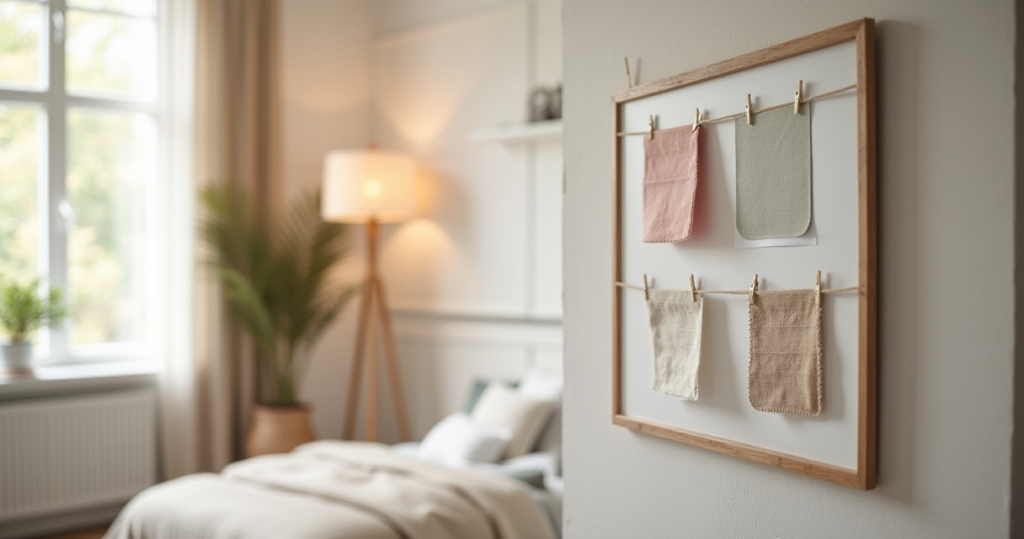Picture this: you’re standing in a perfectly nice, perfectly beige bedroom. The furniture is fine. The bedding is fine. Everything is… fine. It’s the kind of room you see in a catalogue, a space designed by committee to offend no one. But you know what people always ask me? “Jasmine, how do I make my room feel like me? How do I bring in the warmth, the color, the stories of my heritage without it looking like a chaotic museum?”
For generations, homes across India, from the royal havelis of Rajasthan to the simple, sun-baked courtyards of the South, have mastered the art of creating spaces that feel alive. They do it with soul, not with a massive budget. This isn’t about the minimalist, ‘less is more’ approach you see everywhere; this is the secret of joyful, soulful living—it’s about layers, stories, and the human touch.
Can we talk about the biggest lie in modern design? That a vibrant, culturally rich home is “too much” or “cluttered.” That’s corporate speak for “buy our matching beige set.” What actually matters is creating a sanctuary that sings your story. I’m going to share the shortcuts, the secrets I’ve learned from artisans and my own design mistakes, to help you craft a bedroom that feels like a warm embrace. Forget the noise about expensive trends; let’s talk about what’s timeless.
Smart Planning & Foundational Budget Strategies (Part 1)
Before you even think about a paint swatch or a piece of fabric, the magic begins with a plan. But not a sterile spreadsheet—think of this as gathering the spices for the most incredible dish. It’s about understanding your ingredients, honoring what you already have, and knowing which flavors will have the most impact. This is where you set the intention for your space, ensuring every choice is filled with purpose and personality.
1. Define Your Desired Aesthetic with a Free Digital Mood Board
Everyone will tell you to make a mood board, but they often miss the soul of it. Forget just pinning generic “boho” rooms. Your mood board should be your personal “masala box” of inspiration. It’s where you gather the saffron yellows of a sunset you remember, the deep indigo of a bandhani sari your grandmother wore, the texture of a hand-carved wooden pillar you saw on your travels. This isn’t just a design tool; it’s a visual diary of what makes your heart sing. It becomes your compass, protecting you from buying that trendy-but-lifeless grey cushion.
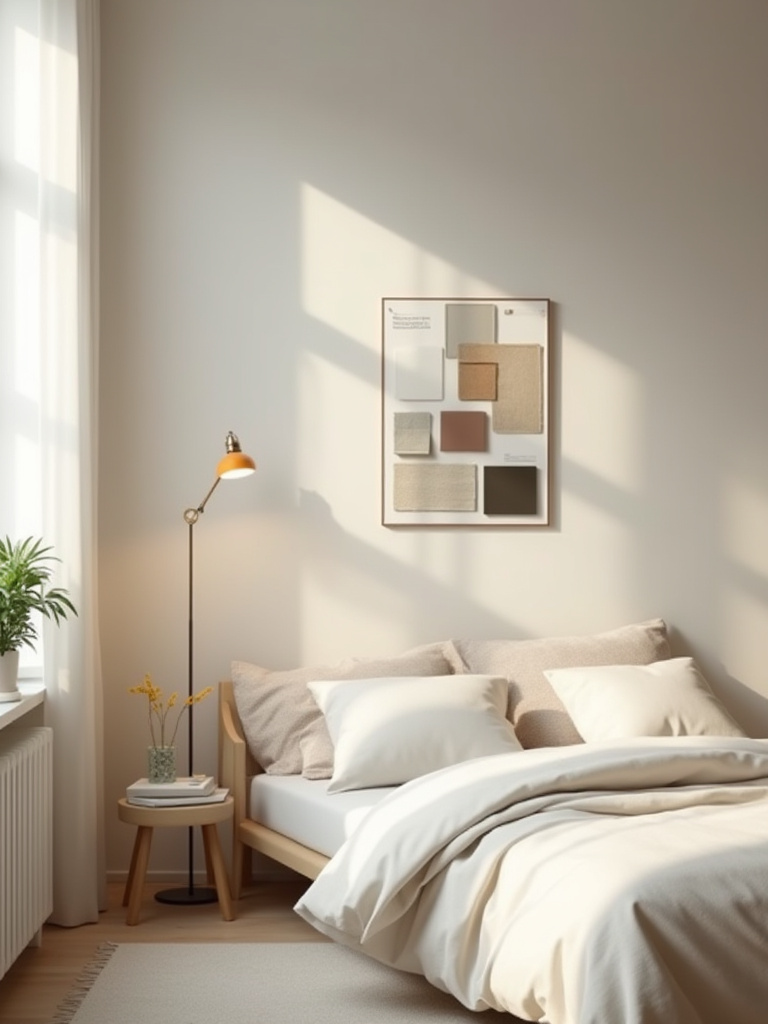
Start by collecting images that give you a feeling, not just a look. A picture of a bustling spice market, the intricate patterns of a jali screen, the soft light of a diya lamp. Use Pinterest, yes, but also scan old photos, fabric scraps, and postcards. When you put a picture of a minimalist Scandinavian chair next to a vibrant piece of Rajasthani mirror work, what story do they tell together? This process ensures that when you finally spend money, it’s on a piece that truly belongs in your story, not someone else’s catalogue.
This step is your secret weapon against blandness and budget blowouts. A clear vision stops you from making those “it was on sale!” mistakes that end up gathering dust. It’s the thoughtful pause before the joyful creation.
2. Conduct a Thorough Room Audit to Identify Upcycling Opportunities First
Okay, my biggest pet peeve is the “declutter by trashing everything” advice. The whole concept is so wasteful and ignores the stories already living in your home! Before you buy a single new thing, look around with new eyes. That old wooden chest from your parents? It’s not junk; it’s a beautiful sandook waiting for a polish and a new life at the foot of your bed. That collection of mismatched silk scarves? They’re the makings of a stunning, one-of-a-kind patchwork cushion cover.
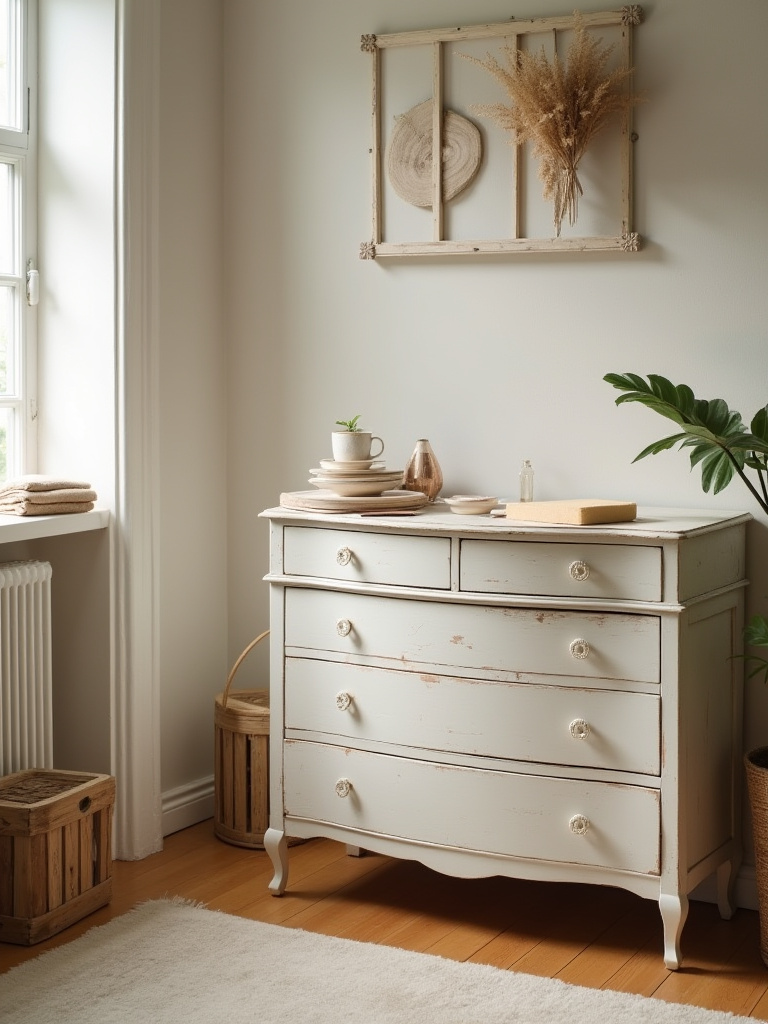
This isn’t just about saving money; it’s about honoring history. Indian households have mastered the art of repurposing for centuries. An old sari is never just thrown away; it becomes a baby’s quilt (a godhri), a bag, or is woven into a rug. I once worked with a client who had a box of her mother’s old Banarasi silk saris, too worn to be worn. We carefully cut the most beautiful patterned sections and had them framed in simple gold frames. The gallery wall we created was more stunning and meaningful than any expensive art she could have bought.
So, walk through your room and your storage. What fabrics can be reborn as cushion covers or a headboard? What wooden item just needs a bit of love? Your most unique pieces are often the ones you already own.
3. Establish a Realistic, Detailed ‘No-Splurge’ Budget for Every Element
Let’s be real: “budget” can feel like a restrictive, uncreative word. But I want you to think of it as your framework for creativity. Having clear limits is what forces you to be resourceful and clever, and that’s where the most brilliant ideas are born. When you can’t just buy the expensive thing, you’re pushed to find a more interesting solution—like hunting for a vintage brass lamp instead of a generic new one, or block-printing your own curtains instead of buying designer ones.
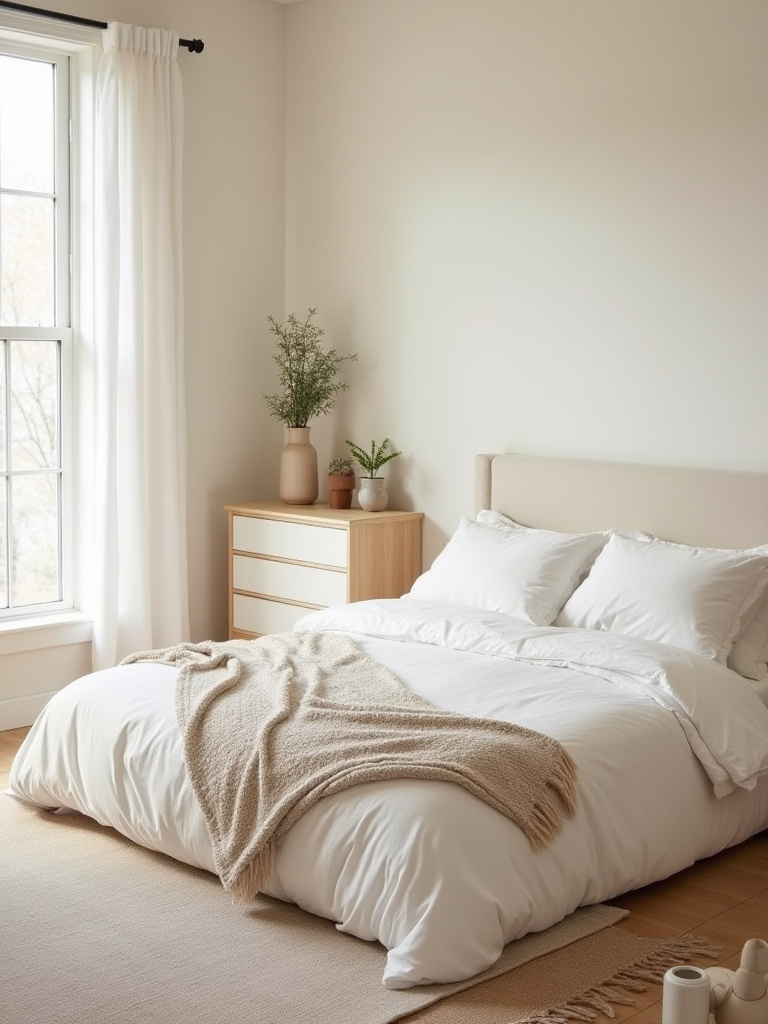
Create simple categories: Paint, Textiles (this is a big one!), Lighting, Art & Decor, and a little “Magic Fund” for unexpected treasures you might find. Assign a number to each. The real secret here is to be honest about where the joy is for you. If a gorgeous, hand-stitched Kantha quilt is the piece your whole room will be built around, allocate more there and save on something else, like the bed frame itself. This isn’t about restriction; it’s about mindful allocation.
This detailed plan is your permission slip to spend guilt-free within your limits. It keeps the process fun and turns it into a creative challenge rather than a source of financial stress.
4. Prioritize High-Impact Changes That Offer the Best Visual Return on Investment
If you only have a small amount to spend, where do you put it for the most dramatic transformation? The answer is always, always in two places: the wall behind your bed and the bed itself. These are the soul of the bedroom. Forget spending money on a bunch of tiny little trinkets that will just become clutter. Go big, be bold, and focus your energy here.
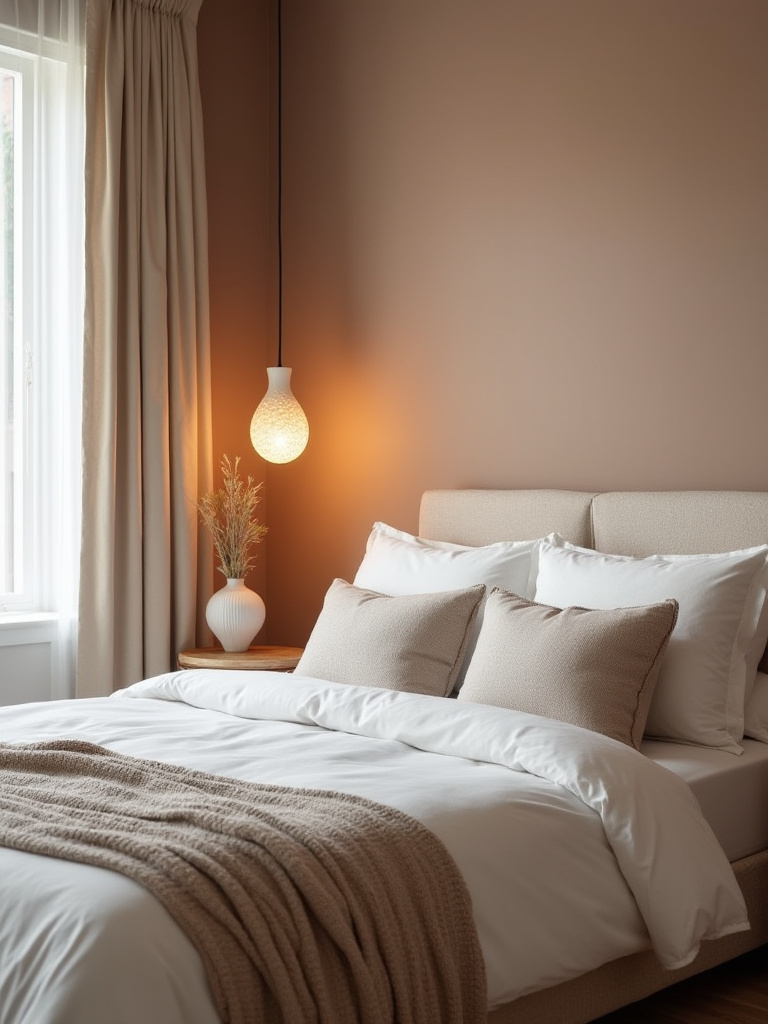
One gallon of rich, peacock-blue paint for an accent wall will do more for your room than ten small, generic decor items. Similarly, a single, stunning block-printed duvet cover can instantly change the entire mood of the space. Think of it like cooking: a few high-quality spices have more impact than a cupboard full of bland ingredients. The BS everyone tells you is that you need to change everything. You don’t. You need to change the right things.
I wish someone had told me this earlier in my career. I spent so much time fussing over tiny details when a bold stroke was what was needed. Your shortcut is this: invest your budget in color on the wall and pattern on the bed. Everything else will just fall into place around it.
Smart Planning & Foundational Budget Strategies (Part 2)
Now that we’ve laid the groundwork, let’s clear the stage. A truly magnificent performance needs a clean, uncluttered space where the stars of the show—your beautiful textiles, your meaningful art—can truly shine. This phase is about creating that clean canvas and gathering endless inspiration without spending a single rupee.
5. Declutter Ruthlessly to Maximize Existing Space and Create a Clean Canvas
I’m going to say this with love: you cannot welcome new energy into a space that is full of stagnant old stuff. Decluttering isn’t about creating a sterile, empty box. It’s about making room for peace. It’s about letting your beautiful things breathe. Start with one small corner, one drawer. Don’t try to tackle the whole room at once or you’ll get overwhelmed and give up. Ask yourself not just “do I need this?” but “does this bring me a feeling of lightness and joy?”
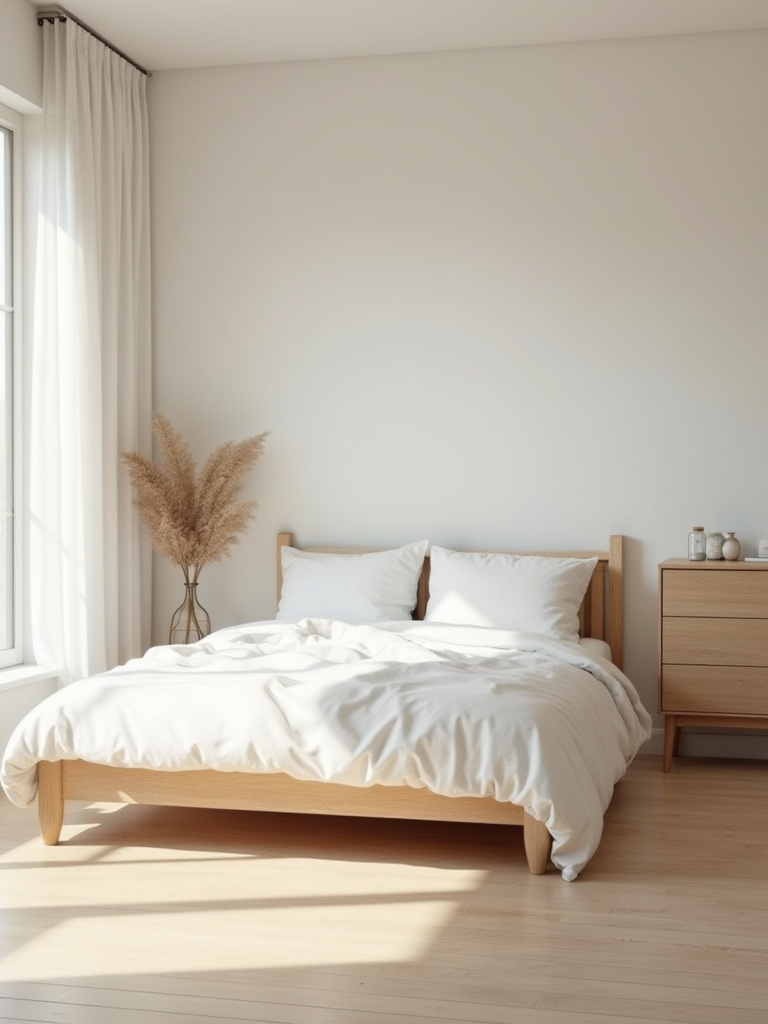
In the Indian philosophy of Vastu Shastra, which is a bit like Feng Shui, clutter blocks the flow of positive energy. Whether you believe that or not, it absolutely blocks the flow of you walking to your closet! By clearing out what no longer serves you, you’ll be amazed at how much larger and calmer your room feels. You’re not just creating physical space; you’re creating mental space for rest and renewal, which is what a bedroom is for.
This step is the most powerful and is completely free. It’s the foundation upon which every other beautiful choice will be built. You honor your space by clearing it first.
6. Source Inspiration from Free Online Galleries and DIY Blogs for Ideas
The internet is your free, infinite library of inspiration. But you have to be a smart curator. It’s easy to get lost in a sea of sameness. My advice? Look beyond the big design sites. Search for things like “Jaipur block printing,” “Kutch embroidery,” “Chettinad homes,” or “Indian textile art.” Dive deep into the specific crafts and aesthetics that make your heart beat a little faster. Look at blogs from travelers who have photographed markets in Delhi or temples in Tamil Nadu.
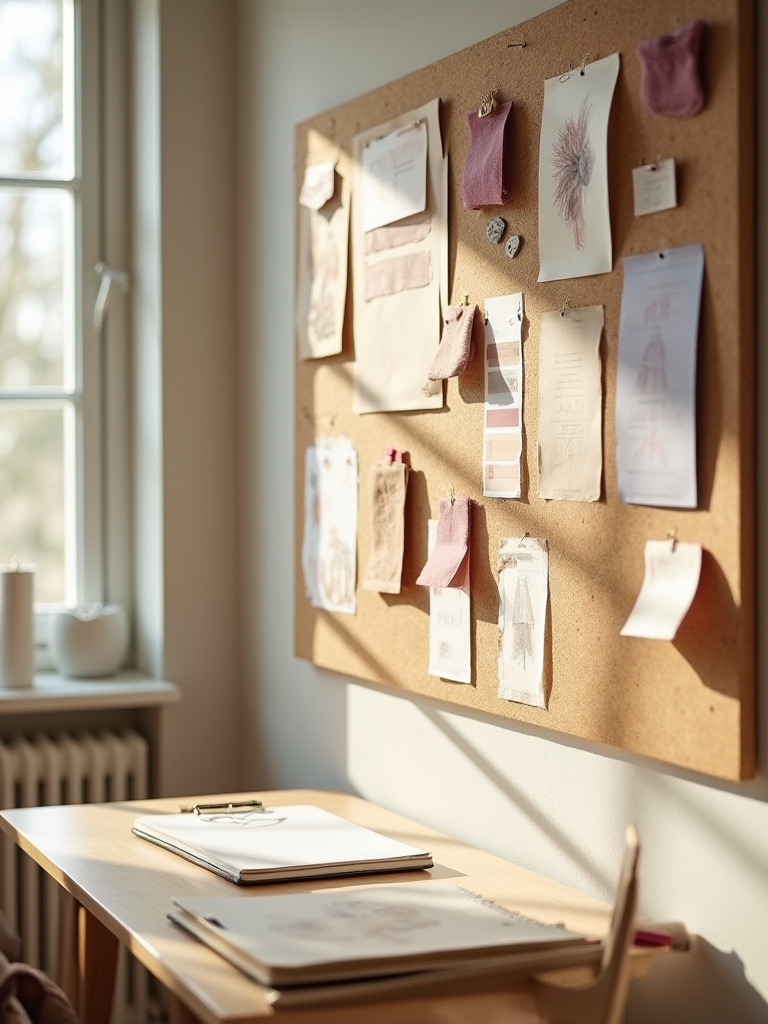
This is where you find the authentic ideas that you won’t see in your neighbor’s house. I learned how to create a stunning temporary wall feature by watching a YouTube video from an artist in India who used painter’s tape and leftover sample paints to create a geometric design inspired by traditional rangoli patterns. The resources are out there. Instead of just looking for “bedroom ideas,” search for the stories, crafts, and colors that resonate with you personally.
This deep-dive approach will fill your well with unique, achievable ideas that feel genuine, not just copied from a mainstream blog.
Cost-Effective Color, Furniture & Lighting Transformations (Part 1)
This is where the real fun begins. Color is emotion. It’s energy. And it’s the single most affordable tool you have to completely change the feeling of your room. Here, we’ll talk about transforming your space with paint and smart furniture tricks, turning what you have into what you love without spending a fortune.
7. Choose an Affordable Paint Color to Dramatically Shift the Room’s Mood
Forget boring beige or sad grey. A can of paint is the cheapest ticket to a whole new world. And in Indian culture, color is never just color; it’s packed with meaning and energy. Think about painting an accent wall behind your bed in a deep, moody indigo blue, a color associated with the divine Krishna—it’s instantly calming and majestic. Or what about a warm, welcoming turmeric yellow that feels like sunshine and is associated with auspicious beginnings?
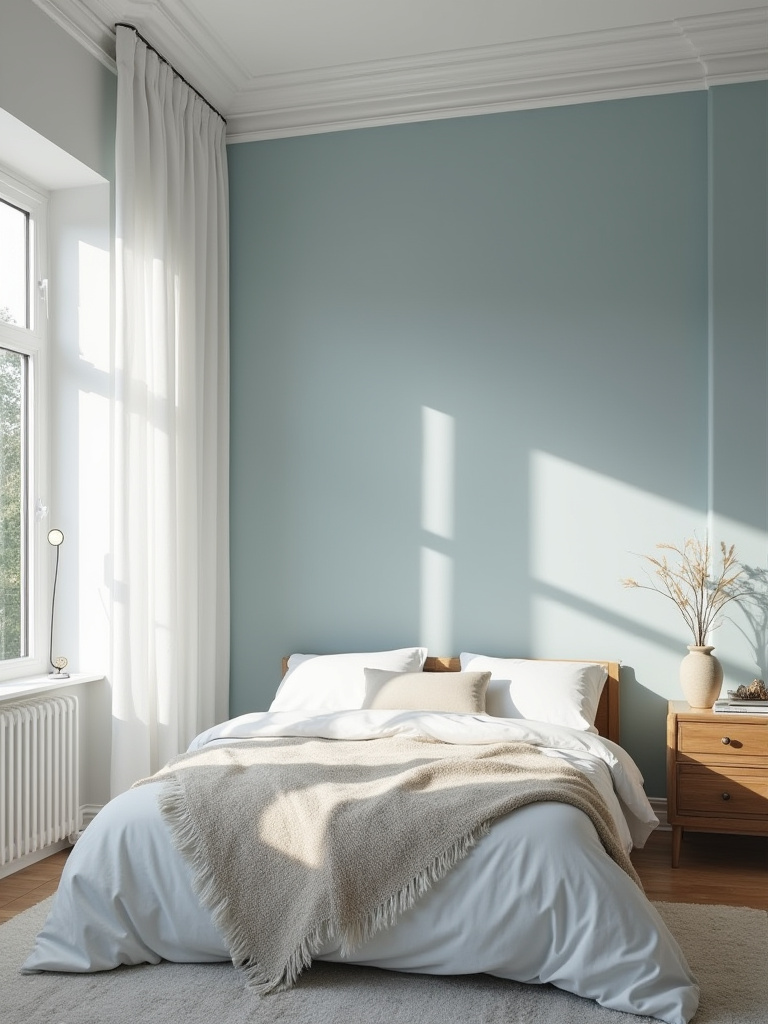
A confession: I used to be afraid of bold color. I thought it would make a room feel smaller. But then I visited the city of Jodhpur, the “Blue City,” where entire houses are painted the most brilliant shade of blue, and they feel vast and serene. The trick is to choose one wall to be your “hero” and keep the others a soft, warm white. That single wall will give your room depth and a powerful focal point.
Don’t just pick a color from a tiny chip. Get a sample pot, paint a large piece of cardboard, and move it around the room to see how it looks in the morning light and in the evening. This is the single biggest “bang for your buck” change you will ever make.
8. Create a Stylish Accent Wall with Budget-Friendly Stencils or Masking Tape Designs
If a solid wall of color feels like too much, an accent wall with a pattern is your answer. You don’t need expensive wallpaper! The most beautiful patterns can be made with your own two hands. One of my favorite tricks is to find a traditional wooden printing block—you can find them for a few dollars online or in speciality shops. Using a little bit of paint on the block, you can stamp a gorgeous, repeating pattern, like a classic buti (flower) or paisley design, onto your wall. The little imperfections are what make it beautiful and unique.
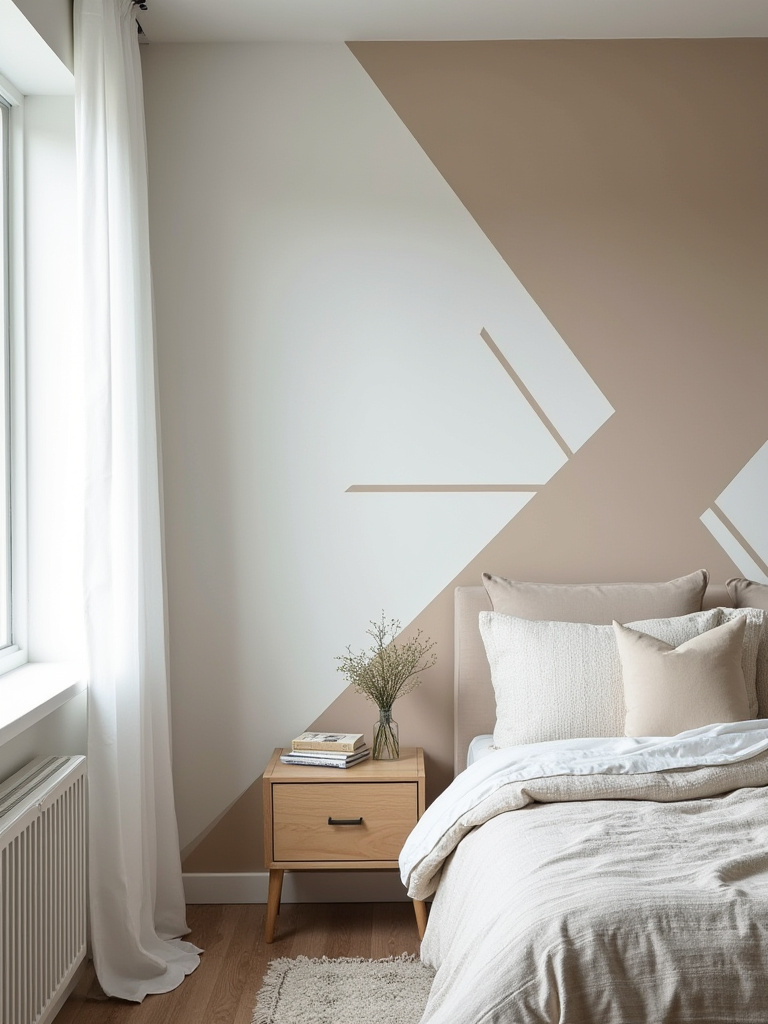
Another incredibly simple method is using painter’s tape. Create a bold geometric pattern inspired by jali screens or even a herringbone design that mimics traditional weaving. Paint over the tape, and when you peel it away, you have a crisp, custom design that looks like a million bucks. A friend did this with metallic gold paint over a navy blue wall, and the result was absolutely breathtaking—a little bit Art Deco, a little bit Jaipur palace.
This is your chance to play and create something that is truly yours. It costs next to nothing and adds a layer of artistry and intention that makes your room feel incredibly special.
9. Reposition Existing Furniture to Optimize Flow and Maximize Perceived Space
Before you buy a single thing, try shopping in your own home. The flow, or energy, of a room can be completely transformed just by moving the furniture around. I once walked into a client’s room where the bed was pushed against the same wall as the door. The energy felt blocked and unsettling. We simply moved the bed to the opposite wall, so it was the first thing you saw when you walked in, and the entire room breathed a sigh of relief.
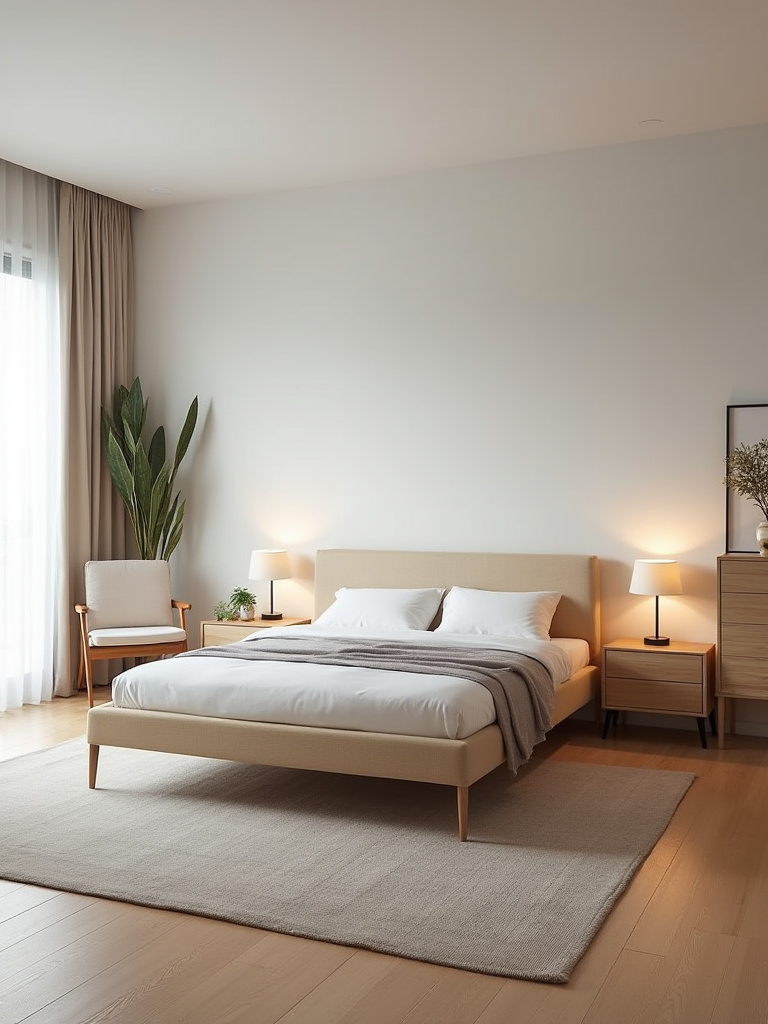
Draw a little map of your room on paper and cut out small pieces to represent your furniture. Move them around on paper first before you start dragging heavy things. Can you pull your bed away from the wall and put a slim console table behind it? Can you create a small, cozy reading corner by angling a chair near the window? Often, we push everything flat against the walls, but “floating” a piece or two can create a much more dynamic and spacious feeling.
This costs nothing but a little bit of time and muscle, and the results can be just as dramatic as a new coat of paint. Don’t underestimate the power of a fresh perspective.
10. Upgrade Existing Furniture with New Handles, Knobs, or a Fresh Coat of Paint
That boring dresser you’ve had forever? It’s a blank canvas. One of the quickest shortcuts to a high-end look is changing the hardware. Swap out those generic metal knobs for something with personality. Think colorful ceramic knobs from Rajasthan, beautiful brass pulls, or even handmade tassels tied to the handles. It’s like changing the jewelry on an outfit—a small detail that makes a huge impact.
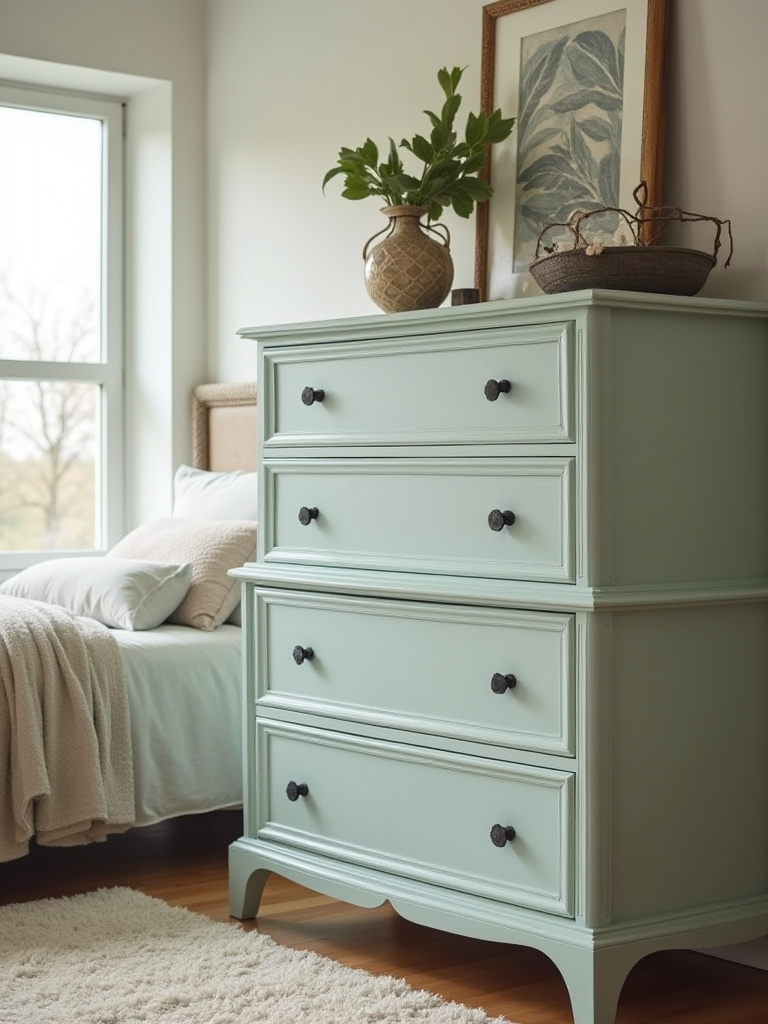
And never underestimate the power of paint. A dark, heavy piece of furniture can be made light and airy with a coat of white or soft color. Or go bold! I painted an old, tired side table a vibrant marigold orange, and it became the most joyful and commented-on piece in my entire home. For a truly unique touch, you can paint a traditional pattern—a simple border or a motif on the drawer fronts—using a stencil or by hand.
This is how you get a custom look without the custom price tag. You’re not just re-finishing furniture; you’re infusing it with your own creative spirit.
Cost-Effective Color, Furniture & Lighting Transformations (Part 2)
Light is everything. It sets the mood, makes a space feel larger, and can be manipulated to create pure magic. In this section, we’ll talk about how to play with both natural and artificial light to make your bedroom feel like a radiant, welcoming sanctuary, all on a shoestring budget.
11. Maximize Natural Light with Sheer Curtains and Strategically Placed Mirrors
Heavy, dark curtains can suck the life right out of a room. Unless you need total blackout for sleep, I always recommend light, airy fabrics. Think sheer cotton voile or linen curtains that let the light filter through softly. In India, you often see windows adorned with these beautiful, breezy fabrics that dance in the wind. They provide privacy while still allowing the space to feel bright and open. Look for curtains with a subtle block print or a delicate embroidered border for an extra touch of craft.
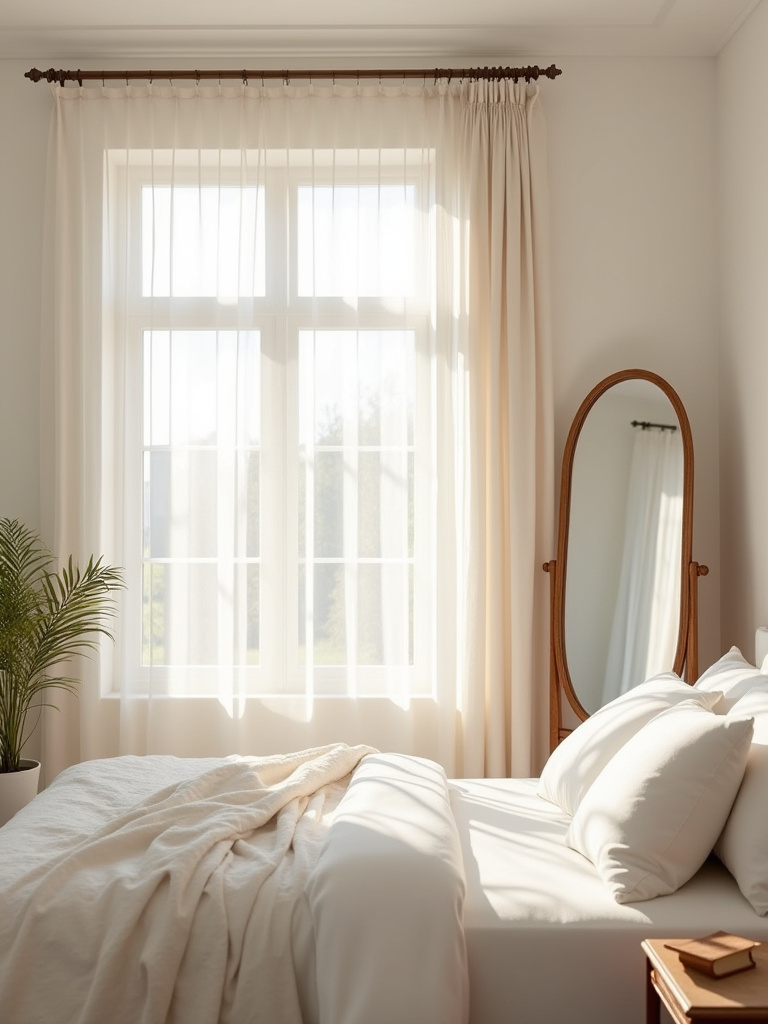
The second part of this magic trick is a mirror. Find the biggest mirror you can afford (thrift stores are amazing for this!) and place it on the wall opposite your main window. It will literally grab the light from outside and bounce it all around the room, making the entire space feel brighter and doubling the feeling of space. An ornate, vintage frame, even if it’s a bit chipped, adds so much more character than a simple modern one.
This simple duo—sheer curtains and a big mirror—is a designer’s secret weapon for transforming a dark, small room into a bright and expansive-feeling retreat.
12. Revamp Lighting Fixtures with Inexpensive Shades or Energy-Efficient Bulbs
Lighting can make or break a room, but you don’t need to hire an electrician to fix it. Look at your existing lamps. Can you change the lampshades? A boring beige shade can be swapped for one with a beautiful color or pattern. Even better, you can easily make your own. Buy a simple, cheap drum shade and cover it with a beautiful piece of fabric—a scrap of silk, a block-printed cotton—using spray adhesive. It’s a ten-minute project that instantly adds a custom, designer touch.
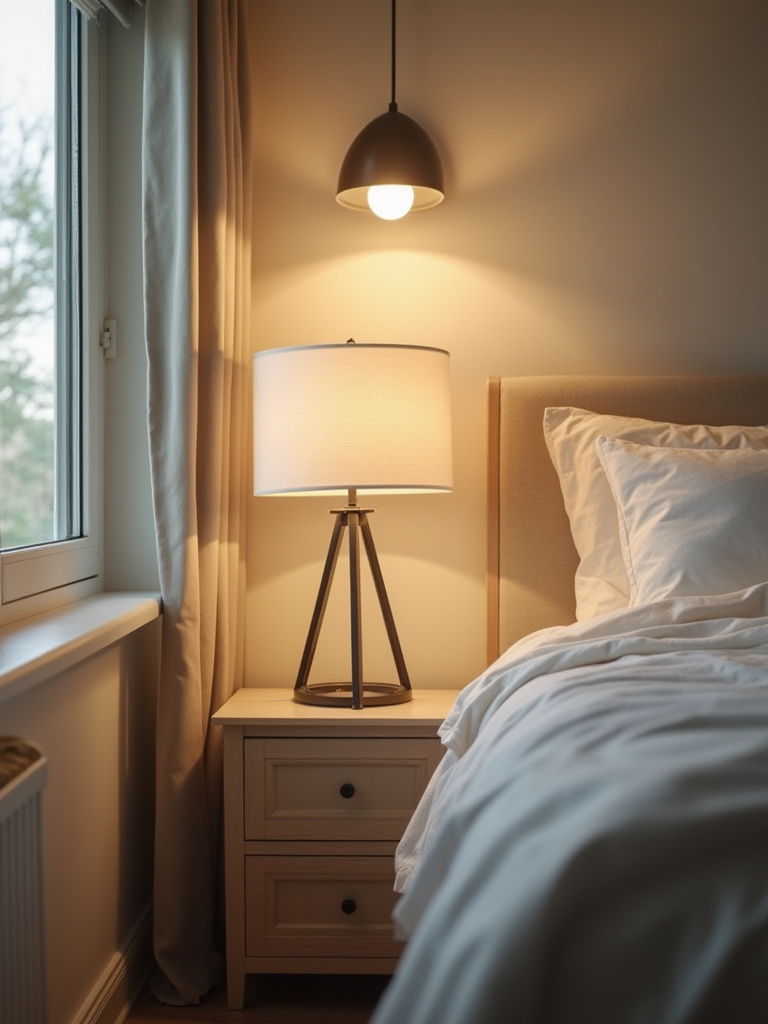
Also, pay attention to your light bulbs! Most people use bulbs that are way too cool and harsh for a bedroom. You want a warm, soft glow that feels like candlelight. Look for bulbs with a “warm white” or a low Kelvin rating (around 2700K). This small, inexpensive change will make your bedroom feel instantly cozier and more inviting. Layer your lighting: have an overhead light, a reading lamp by the bed, and maybe a small lamp on a dresser to create pools of warm light.
These subtle tweaks to your lighting create a layered, warm ambiance that is crucial for a restful sanctuary. It’s a small change that has an enormous impact on the mood.
Creative Decor & Textile Enhancements on a Shoestring (Part 1)
Now for my favorite part: the layers of softness and personality that turn a room into a home. Textiles are the soul of Indian design. They carry stories in their threads, patterns, and colors. This is how you add comfort, art, and personal history to your space without spending a fortune.
13. Refresh Bedding with a New Duvet Cover or Thrifted Fabric for a Cohesive Look
Your bed is the heart of your room. Make it spectacular. A beautiful duvet cover is the single most important textile you can buy. Look for something special, like an Ajrakh block print from Gujarat or a soft, hand-blocked Dabu print from Rajasthan. These aren’t just bedspreads; they are works of art, created by artisans who have passed their skills down through generations. You can find them affordably from small sellers on Etsy or direct-from-India shops.
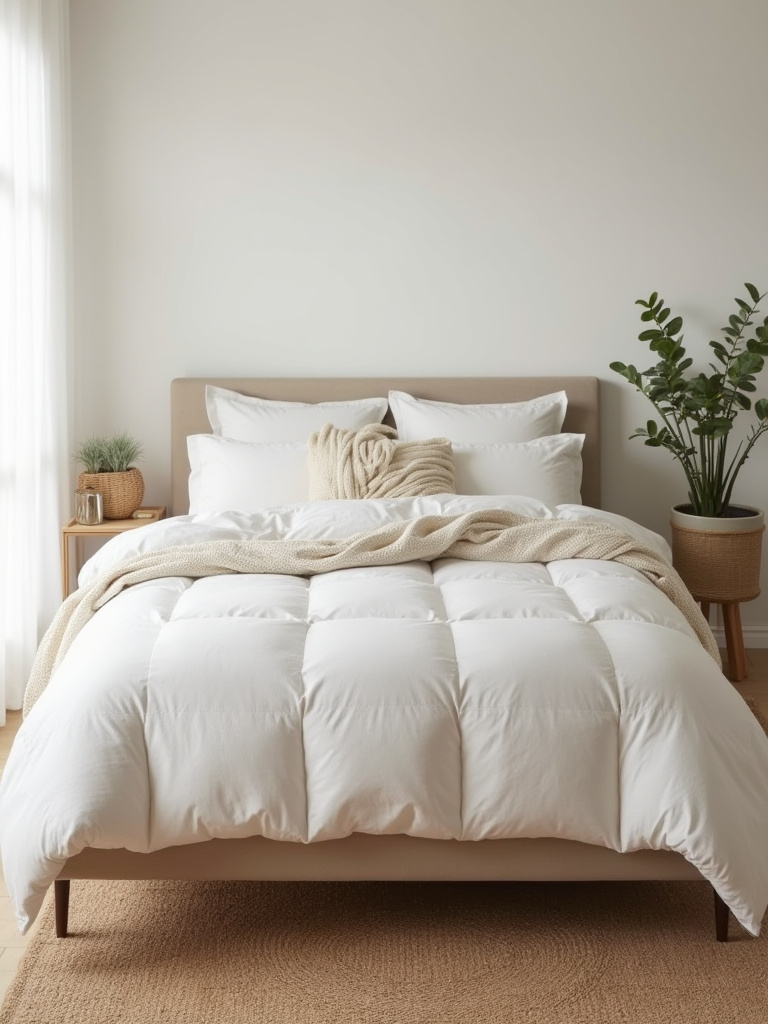
You can also create your own magic. Buy two beautiful flat sheets (called “chaddar”) with complementary patterns and simply sew three sides together to make a duvet cover. Or find a vintage Kantha quilt—a blanket made from layers of old saris stitched together with a simple running stitch. Each one is completely unique and full of history. It can be laid at the foot of your bed for a pop of color and texture.
Don’t settle for a boring, mass-produced comforter set. Your bed is your chance to showcase artistry and incredible pattern. It will instantly elevate your entire room.
14. Craft Personalized Artwork Using Free Online Prints, Photos, or Simple DIY Canvas Art
You do not need to be a famous artist to have beautiful, meaningful art on your walls. One of the most beautiful things you can frame is a piece of textile. Do you have a small piece of a beautiful old sari, an embroidered remnant, or even a stunning printed napkin? Put it in a simple frame. The texture and pattern are often more interesting than a flat print. The BS is that art has to be expensive. The truth is that anything you love can be art.
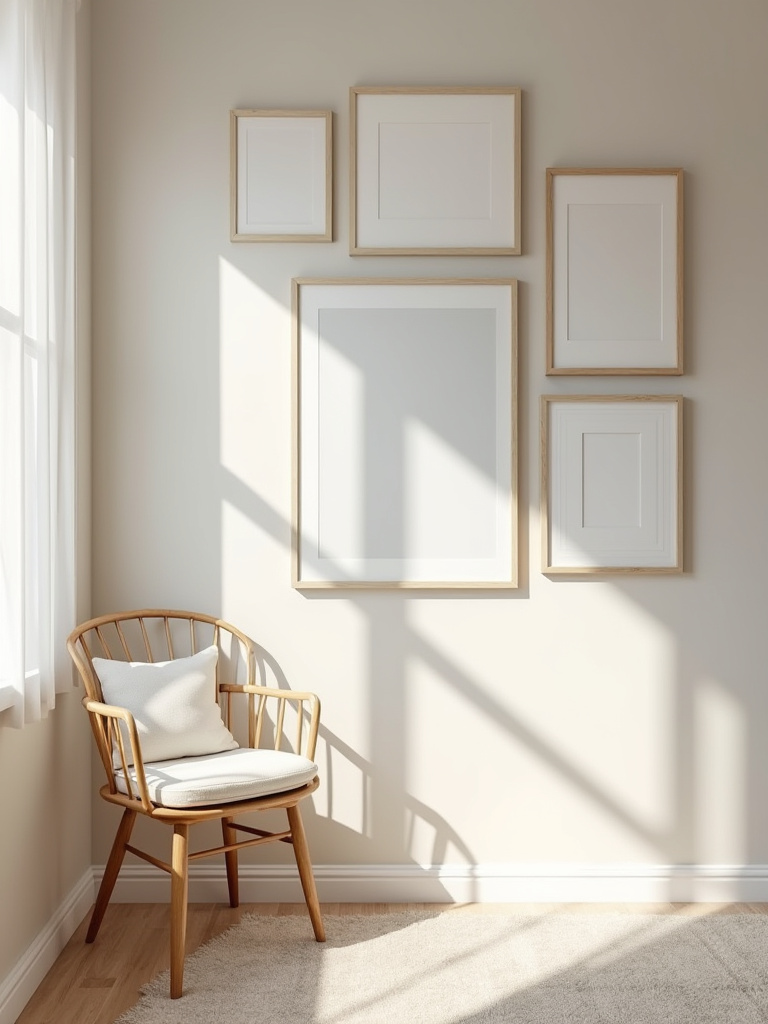
Look for vintage Indian calendar art online—the images of deities like Lakshmi or Ganesha are often stunningly beautiful and can be printed at high quality for very little money. Frame your own travel photos, especially close-ups of architectural details, colorful doors, or market scenes. Or, buy the cheapest canvas you can find and do a simple abstract painting using just two or three colors from your room’s palette. Don’t overthink it; just play with color and texture.
Your art should tell your story. It should be the things that make you smile when you see them. That personal connection is worth more than any price tag.
15. Add Cozy Textures with Budget-Friendly Throw Pillows and Blanket Layers
A bed without layers of pillows is like a curry without spice—it’s just missing something! This is where you can have so much fun with texture and pattern. The key is to mix, not match. Start with your two sleeping pillows, then add two larger square pillows (called Euro shams) against the headboard. In front of those, add one or two smaller, decorative cushions.
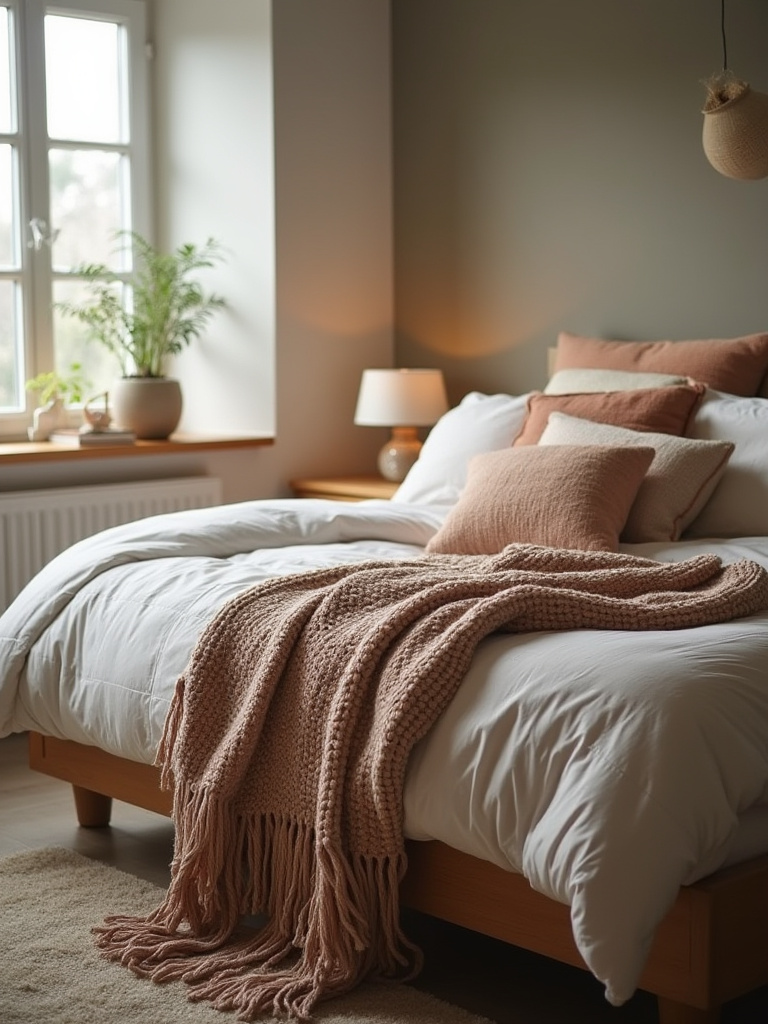
Look for cushion covers with interesting textures: a rough, nubby hand-loomed cotton (khadi), a cushion with mirror-work embroidery (shisha), or one with playful tassels. Mix a bold pattern with a simple solid. Then, at the foot of the bed, add a folded throw or a light quilt. A Kantha throw is perfect for this, as is a simple waffle-weave or chunky knit blanket. These layers are what make a bed look inviting and luxurious.
“A room should feel collected, not decorated. Layers of textiles from different places and times tell the story of a life well-lived.”
You can find inexpensive and beautiful cushion covers from online sellers who work directly with artisan communities. This is an easy way to support traditional crafts while making your room stunning.
16. Design an Eye-Catching Gallery Wall with Inexpensive Frames and Personal Mementos
A gallery wall is a fantastic way to fill a large, empty space with personality. The secret to making it look cohesive, not chaotic, is to unify the frames. Go to a thrift store and buy a bunch of mismatched wooden frames in all different sizes. Then, take them all outside and spray paint them one single color—matte black, warm gold, or even a vibrant peacock blue. Suddenly, they look like a deliberate, curated collection.
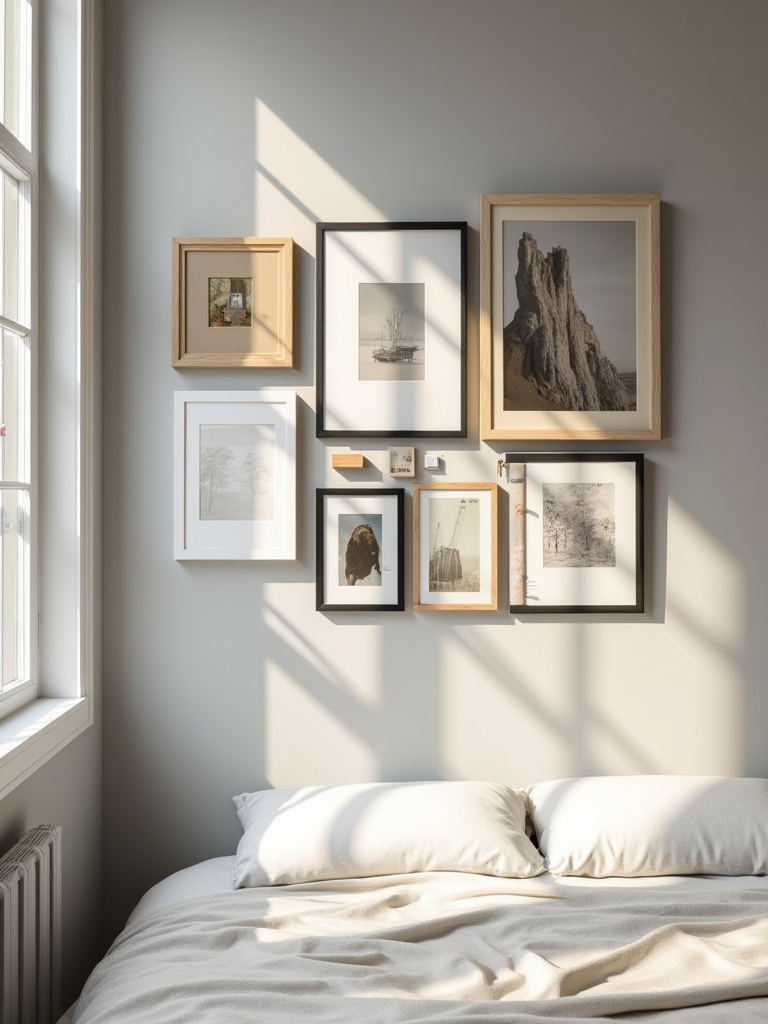
Now for the fun part: filling them. Mix high and low. You can have a professional photo next to your child’s drawing, a postcard from a favorite trip, a framed piece of beautiful handmade paper, and a vintage print you found online. You can even include small, flat objects like an old key, a beautiful fan, or a brass temple token. Lay everything out on the floor first to get the spacing and balance right before you put a single nail in the wall.
This wall becomes the visual heart of your room, a beautiful map of your memories, tastes, and loves. It’s deeply personal and endlessly interesting.
Creative Decor & Textile Enhancements on a Shoestring (Part 2)
We continue our journey with the small, soulful touches that breathe life into a space. This is about inviting nature indoors and celebrating the beauty of imperfect, handmade objects. These final layers of detail are what truly make a space feel complete and deeply comforting.
17. Integrate Greenery with Low-Maintenance indoor plants for Freshness and Color
Every room needs something that’s alive. Plants literally breathe life into a space, purifying the air and adding a welcome touch of nature’s vibrant green. In India, certain plants are considered auspicious and are a common sight in homes. The Tulsi (Holy Basil) plant is sacred, and while it might need more light, having fragrant plants like Jasmine (Mogra) or a pot of marigolds on a sunny windowsill connects you to these traditions.
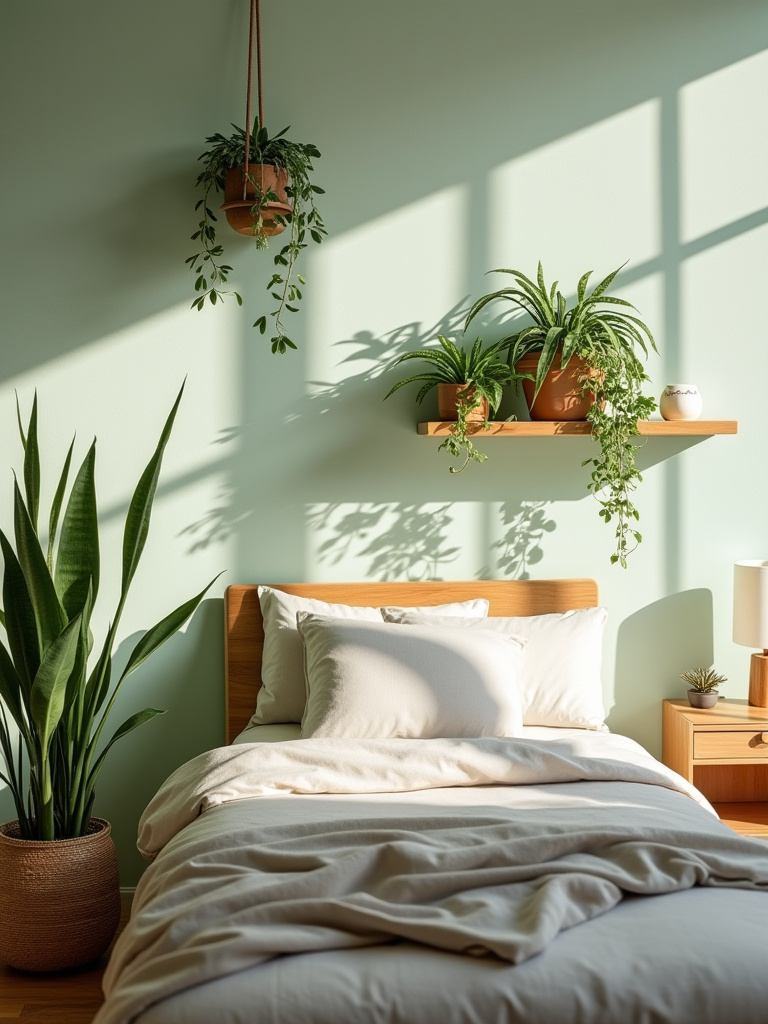
For low-maintenance options that still pack a punch, a snake plant is nearly indestructible and has a beautiful, architectural shape. A pothos plant is wonderful because it trails beautifully from a high shelf or a hanging planter. Don’t just stick them in the plastic pot they came in. Find interesting containers! A vintage brass lassi cup, a painted terracotta pot, or a beautiful ceramic mug can all become charming planters.
Plants soften the hard edges of a room and provide a sense of calm and connection to the natural world, which is essential for a restful sanctuary.
18. Source Unique Decorative Accents from Thrift Stores, Flea Markets, or DIY Projects
This is the treasure hunt. This is where you find the soul of your room. Forget big-box decor stores where everything is mass-produced. The most interesting objects have a past. Scour thrift stores and flea markets for old brass pieces—small bowls (katoris), little bells, candle holders, or trays. Even if they’re tarnished, a good polish will bring them back to glorious life. Look for carved wooden boxes or small architectural remnants like a piece of an old frame.
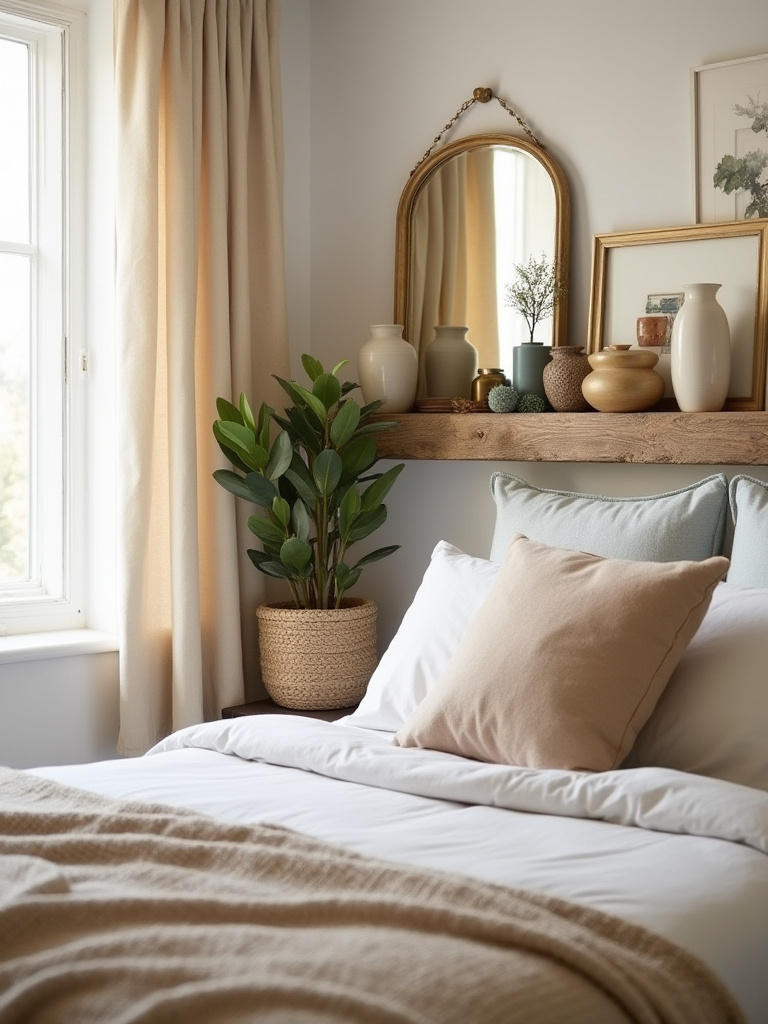
I once found a set of old wooden printing blocks for textiles. I didn’t use them for printing; I simply displayed them on a shelf as beautiful, sculptural objects. They tell a story of craft and human hands. These are the pieces that add history and character. Look for items with patina and a sense of having been loved before.
Your room should be a collection of things that speak to you. These found objects, full of mystery and history, will make your space feel infinitely more interesting than any room filled with new, soulless stuff.
Smart Storage, Finishing Touches & Lasting Organization (Part 1)
A beautiful room is also a functional one. A peaceful mind requires an organized space. But storage doesn’t have to be plastic and ugly. Let’s look at beautiful, clever ways to contain the necessities of life, turning storage solutions into decorative elements in their own right.
19. Implement Vertical Storage Solutions with Inexpensive Shelving Units or Wall Hooks
When floor space is limited, look up! Using your vertical space is the key to making a small room feel larger and less cluttered. Simple floating shelves are fantastic for this. You can display beautiful objects, books, and plants without taking up a single square inch of the floor. Install a high shelf that runs the length of one wall, close to the ceiling, for storing things you don’t need every day in beautiful baskets.
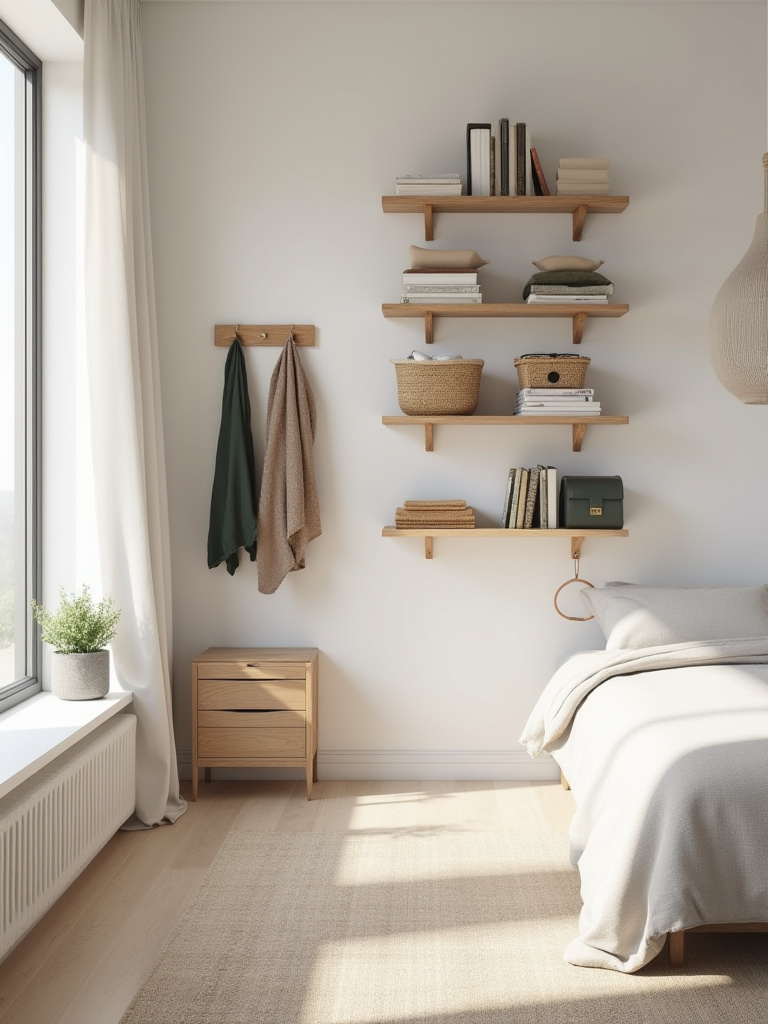
Also, think beyond the closet for hanging things. A series of beautiful, decorative hooks on the wall can be a place to hang your necklaces, scarves, or even a favorite robe. It becomes a functional piece of art. I love finding old, ornate brass hooks that add a touch of vintage glamour. You can also mount a beautiful piece of driftwood or a copper pipe to the wall and use S-hooks to hang items.
By using your walls wisely, you free up the floor, which instantly makes the room feel more open, airy, and organized.
20. Tame Clutter with Decorative Baskets and Boxes to Conceal Essentials
Clutter is the enemy of calm. The secret to a tidy room is to have a beautiful home for everything. Woven baskets are a lifesaver. Use a large one on the floor for extra blankets or laundry, and smaller ones on shelves or your nightstand to corral all the little things—chargers, remote controls, hand lotion, books. Baskets made from natural fibers like seagrass, jute, or sabai grass add wonderful, earthy texture to a room.
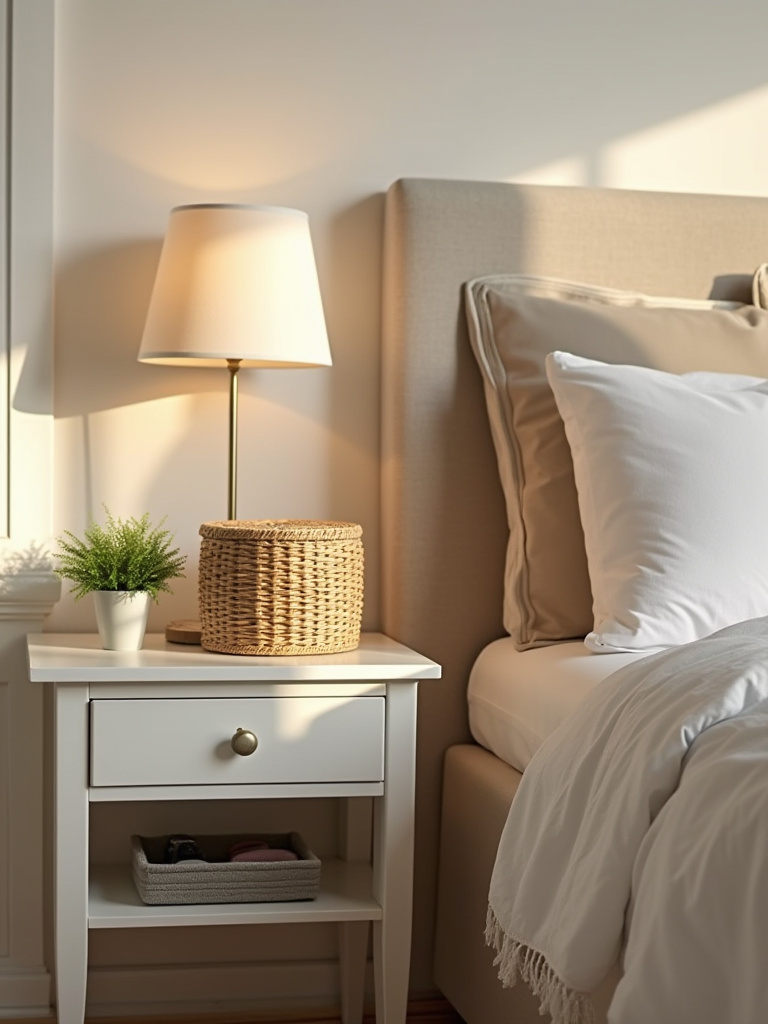
You can also find beautiful decorative boxes. Look for ones made of wood, or ones covered in beautiful handmade paper or fabric. A stack of two or three on a dresser can hide a multitude of sins while looking chic and intentional. This isn’t about hiding your life away; it’s about giving it a graceful, organized home so that your surfaces can remain clear and your mind can remain calm.
When everything has a place, a 5-minute tidy-up at the end of the day is all you need to keep your sanctuary serene.
21. Update Window Treatments with Affordable Curtains or DIY Fabric Blinds
We talked about sheer curtains, but if you want more pattern, this is a perfect opportunity for a DIY project. You don’t need to know how to sew! You can buy inexpensive plain cotton curtain panels and customize them. One of the easiest and most impactful techniques is to use fabric paint and a simple stencil or potato stamp to create a border design along the bottom or sides.
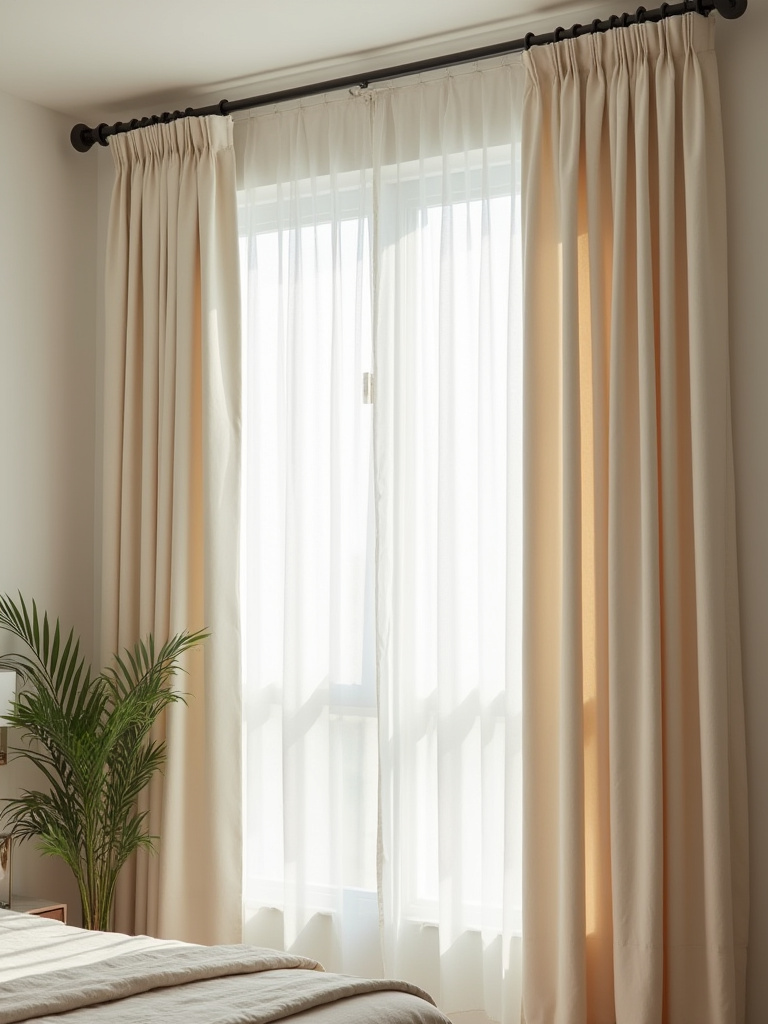
Another beautiful option is to buy a length of stunning block-printed fabric. Simply use iron-on hem tape to finish the edges—no sewing machine required! Then hang them using simple clip-on curtain rings. You get a completely custom, high-end designer look for the price of a few yards of fabric. This is a perfect way to bring a large-scale pattern into the room without overwhelming it.
Your windows are a huge piece of visual real estate. Dressing them beautifully and affordably is a non-negotiable step for a finished, polished look.
22. Add an Area Rug (Even a Small One) to Define Space and Add Warmth
A rug is what pulls the whole room together. It grounds the furniture and adds a crucial layer of softness and warmth underfoot. Even if you have carpet, a smaller area rug layered on top can add color, pattern, and define the sleeping area. A rug that is too small is a classic design mistake; you want at least the front legs of your bed and nightstands to be sitting on it.
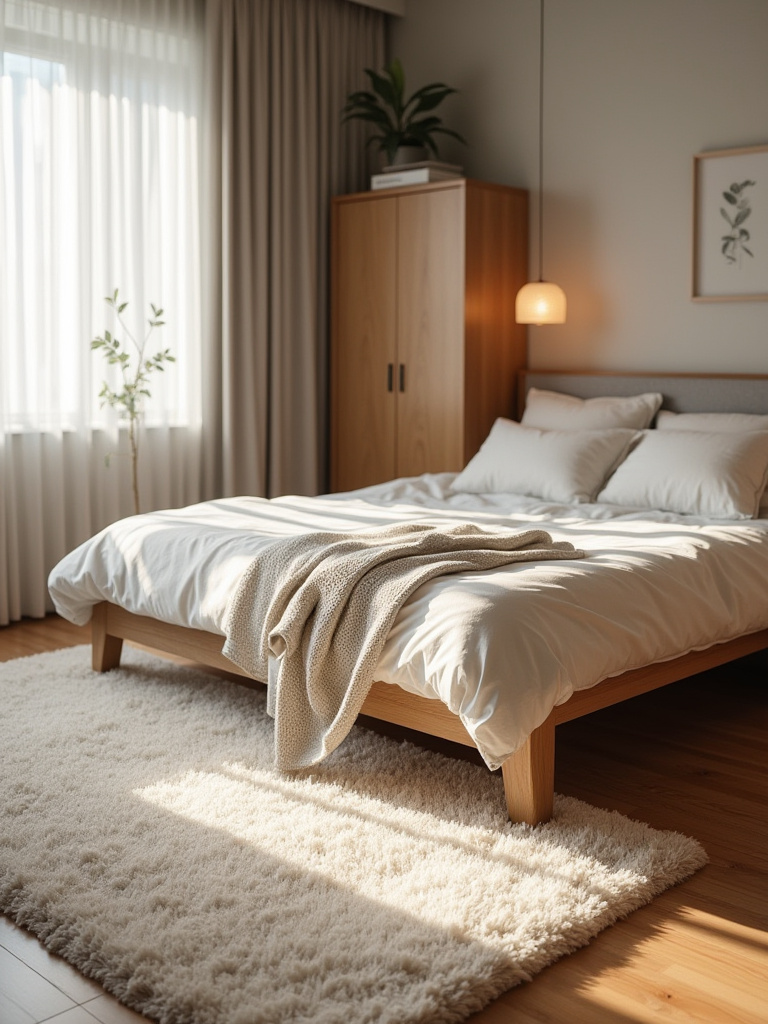
Dhurries are a fantastic, budget-friendly option. These are flat-woven cotton rugs from India that come in a million incredible colors and geometric patterns. They are lightweight, reversible, and incredibly durable. A colorful dhurrie can be the foundation for your entire room’s color scheme. Jute or sisal rugs are also great, affordable options for adding natural texture; you can always layer a smaller, more colorful rug on top of one for a sophisticated, layered look.
Never underestimate the power of a rug. It’s the hug for your room, the final element that makes everything feel cohesive, warm, and complete.
Smart Storage, Finishing Touches & Lasting Organization (Part 2)
Finally, we arrive at the most intimate and personal touches. This is about making your bedroom a true reflection of you and ensuring that the beautiful calm you’ve created can be easily maintained. It’s the final brushstroke on your masterpiece.
23. Personalize with Meaningful Keepsakes and Thoughtful Vignettes on Nightstands
Your nightstand is the last thing you see before you fall asleep and the first thing you see when you wake up. Make it a space of beauty and calm. This is not a place for clutter. A “vignette” is just a fancy word for a small, thoughtful arrangement of objects. On your nightstand, this might be a small tray to hold a few meaningful things: a beautiful little bowl for your rings, a framed photo of someone you love, a candle in a scent that relaxes you, and the book you’re currently reading.
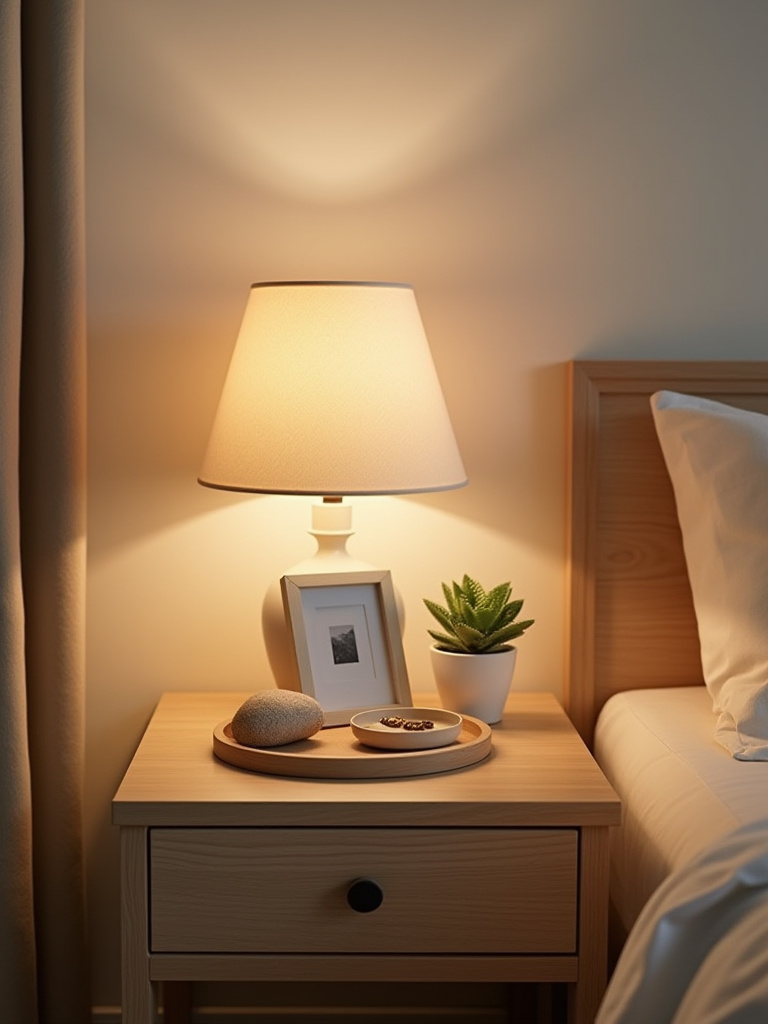
This is your sacred space. Curate it with intention. I have a small, carved soapstone elephant on my nightstand that I picked up on a trip. It reminds me of adventure and strength. These tiny, personal talismans connect us to our memories and our dreams. Keep it simple, keep it beautiful, and keep it meaningful.
This is a tiny detail, but it has a huge impact on how you start and end your day. It’s a small act of self-care and a tribute to your personal story.
24. Establish a Regular Decluttering Routine to Maintain Your Freshly Organized Space
You’ve created a beautiful sanctuary. Now, the key is to protect it. The most important design habit you can cultivate is a simple, daily “closing ceremony” for your room. Before you go to sleep, take five minutes. Put the book back on the nightstand, fold the throw blanket, put the clothes from the day away. It’s a small ritual that shows respect for your space and for yourself.
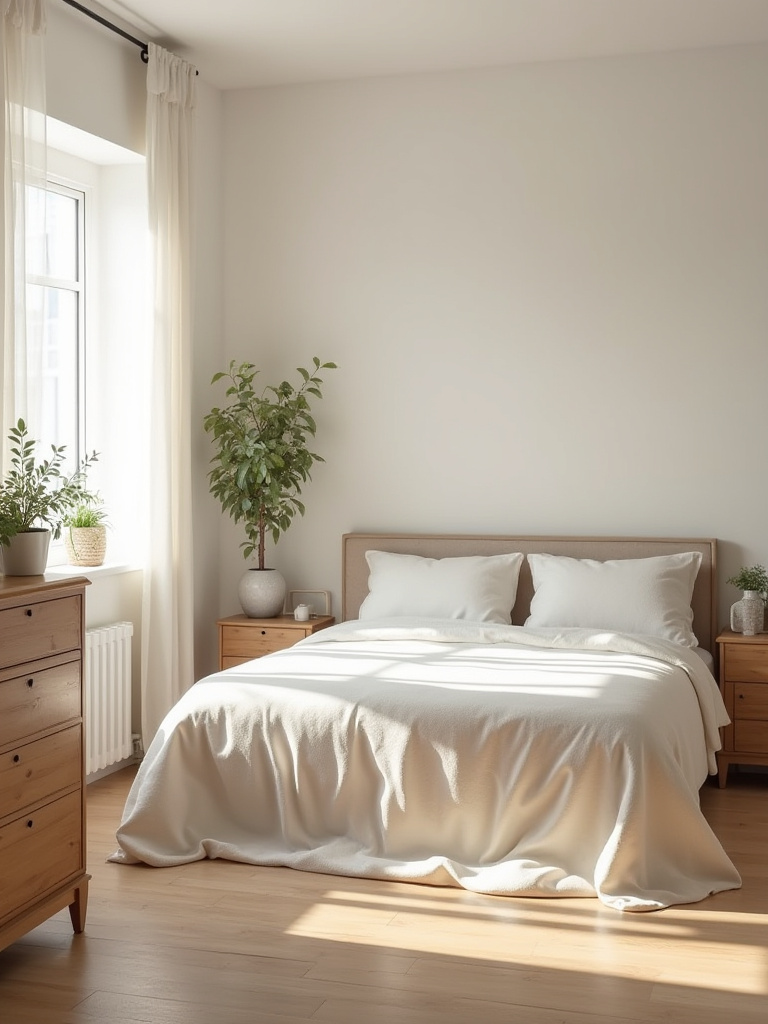
The “One-In, One-Out” rule is also a game-changer. When you buy a new cushion cover, let an old one go. When you buy a new book, donate one you’ve already read. This simple discipline prevents the slow, creeping return of clutter and ensures that your room remains a curated collection of things you truly love and use. This isn’t a chore; it’s the practice of maintaining peace.
Your beautiful bedroom makeover isn’t a one-time project; it’s the creation of a new relationship with your space, one based on care, intention, and joy.
Conclusion
There you have it. Your bedroom doesn’t need a huge budget to feel like a palace; it needs your heart, your story, and your hands. We’ve journeyed through the power of soulful color, the magic of handmade textiles, and the simple joy of giving old things new life. These ideas prove that a truly luxurious space is one that is rich in personality, comfort, and peace—qualities that no amount of money can buy.
Don’t let the idea of a “perfect” room paralyze you. Perfection is boring. A home that is alive is one that is full of little imperfections, stories, and the visible touch of the people who live there. So choose one idea from this list—just one!—that makes you feel excited. Maybe it’s finding a beautiful piece of fabric for a new cushion cover or finally painting that accent wall a daring, joyful color. Just start.
Your personal sanctuary is waiting for you. It’s hidden within your own creativity and resourcefulness. With a little bit of inspiration and the courage to embrace color and craft, you can create a bedroom that is not just a place to sleep, but a vibrant, soulful retreat that nourishes you completely. Go create the space you deserve.
